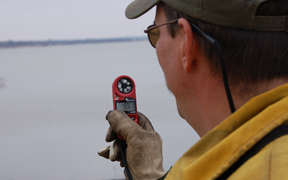
Although controlled burns can be conducted under pre-determined weather conditions, burns can be unsafe if the experience of the burn boss and crew is inadequate.
People new to burning should consider using the 60:40 rule. The 60:40 rule refers to restricting burn conditions to air temperatures less than 60 degrees Fahrenheit and relative humidity (Rh) greater than 40% with a wind speeds of 5-15 mph measured at 6 feet above the surface of the ground.
Rule of Halves
The rule of halves is an easy way to remember how to predict changes in fire behavior when the weather changes. When the air temperature increases by 20 degrees Fahrenheit, the relative humidity decreases by 50%. For example, if the air temperature changes from 60 degrees Fahrenheit with 40% relative humidity to 80 degrees Fahrenheit, the relative humidity will change from 40% to 20%, making the spotfire risk increase dramatically. In most cases, do not burn if there is a forecasted frontal passage or wind shift within 12 hours.
Weather Tools
There are many weather tools available. Make sure and check the wind direction, speed, temperature and relative humidity a few days before the burn, and right before the burn. It is very helpful to take notes of weather conditions during the burn. This can help people learn how to predict fire behavior in the future. On-site weather meters can be very helpful in taking up-to-date weather.
If conditions are not correct, including all parts of the prescription, do not start the fire. If the fire is not going well, put it out. Do not leave the fire until it is completely out, which means no smoke detected for at least one hour.
View this fact sheet for more detailed weather information regarding spotfires: http://pods.dasnr.okstate.edu/docushare/dsweb/Get/Document-2704/NREM-2878web.pdf
